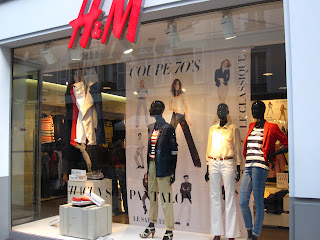As a complex and integral part of the modern world, fashion plays an influential role in society, portraying one’s position, both privately and publically. The store window serves to demonstrate the function of fashion to the public in a manner recreating certain idealized views of society. The different types of stores that exist in our consumer-based society each display different extents of power in their windows, and either retain that power to communicate their message, or give the power to their audience to interpret. Thus it is important to determine who has the power in the outlet of display: the window or the audience?

Chanel window at 31 Rue Cambon
In examination of the store window in Paris, the capital of fashion, the difference in the power of display between a department store window, a luxury store window, and a democratized store window is juxtaposed with their respective and distinct audiences. Although the window controls the power of perception and appearance, it must appeal to the power of its audience and their ability to interpret the window. While the goal of a store window display is to illustrate the vision of the designer, it is heavily influenced by the need to cater to the consumer.






The store window display emerged as a major facet of the culture of consumption in the late 1880s, originating along with the department store. According to William Leach, “windows of city retail stores…revealed to [women] an unobtainable world of luxury” (320). They were meant to initiate a desire within the consumer, and depict an affluent lifestyle that people should strive to achieve, although likely will never quite reach.
Visit Lanvin and their documentation of their window display at: http://www.lanvin.com/#/en/lanvin-today/windows
The presentation of goods or “mise-en-scene” was meant to “seduce” the public and motivate them to buy (Laermans, 92). The power of design and display was in the hands of the store window creator, but the success of the display depended entirely on the audience.
The Parisian department store today has huge, elaborate, extravagant, ornate windows that seem to emulate the same goals and ideas as they did when they were originated and popularized. The luxury store does much the same, but in a simpler manner with a single theme and story illustrated repeatedly. The democratized store conveys a story, yet it attempts to make it a more accessible, relatable theme that its audience can connect to and even rely upon. It is not elaborate or excessive or over-the-top, but fun, practical, and easy-going. However, in the modern consumer society, the domain of power in the fashion window has been transferred from that of the store and its window, to that of the consumer and their interpretation. Jean Baudrillard tells us that today, “every principle of identity is affected by fashion.” Thus interpreting the store windows is based upon one’s personal identity and where they see themselves in relation to the window (463).





Your window shop idea should be very eye catching and i must say that display ideas that you shared is very interesting, looking unique & attractive.
ReplyDeletedisplay boxes
http://www.millsdisplay.com.au/